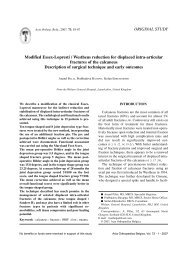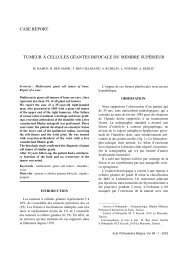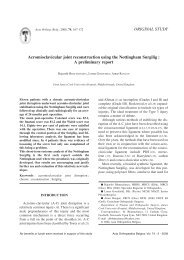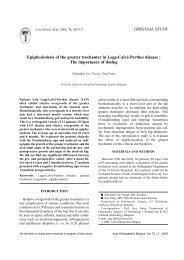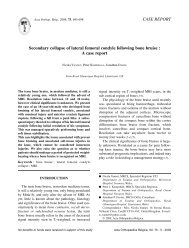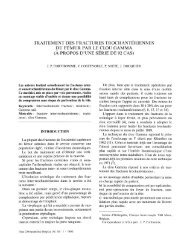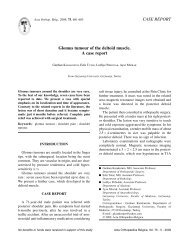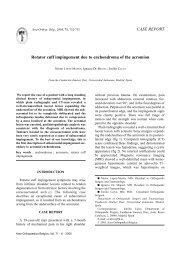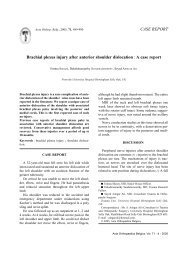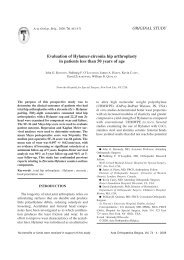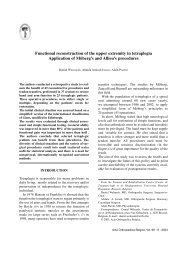download - Acta Orthopaedica Belgica
download - Acta Orthopaedica Belgica
download - Acta Orthopaedica Belgica
Create successful ePaper yourself
Turn your PDF publications into a flip-book with our unique Google optimized e-Paper software.
406 I. J. HARDING, I. M. MORRISfor non-operative treatment in patients withminimal symptoms. Surgery in these ‘minimal’cases resulted in 94% excellent results. With moresevere lesions the success of operative treatmentdecreases to 30% excellent results for simpledecompression, although it is stated this may beimproved with transposition and neurolysis. Whensurgery is indicated the preferred method of interventionremains controversial in the surgical literaturei.e. simple decompression, transposition ormedial epicondylectomy (1, 8, 13) although simpledecompression would seem to be adequate in themajority of cases (1).The aim of this study is to identify aetiologicalfactors in ulnar neuropathy and whether they determinepatient outcome. The anatomical locations ofthese lesions are identified and the roles of nonoperativeand operative treatment are assessed.PATIENTS AND METHODSOne hundred and forty eight consecutive patientswith a diagnosis of ulnar neuropathy between 1994 and1999 were prospectively assessed. The patient details,symptoms, known aetiology and treatment profile wererecorded. A full sensory and motor examination of bothupper limbs was performed including elbow flexion testand Tinel’s test. Where no clear aetiology of lesion couldbe obtained from history or examination e.g. injury(fracture, crush, direct blow), osteoarthritis, recent surgeryetc. then these were termed ‘idiopathic’.All patients had nerve conduction studies (NCS)and/or electromyography (EMG) to confirm the diagnosis.Patients were referred for electrodiagnosis from bothgeneral practitioners (48%) and in-hospital clinicians(52%). This was performed by a single rheumatologist(IMM), with a special interest in this field, who wouldthen instigate treatment depending on the severity, chronicityand progression of the lesion based on clinicalpresentation.All studies were undertaken in warmed limbs, byprior immersion in warm water.The standard tests used included an orthodromiculnar nerve sensory study stimulating with ring electrodesfrom the little finger to recording surface electrodesat the wrist ; these results were compared with the ipsilateralmedian nerve sensory studies from the index fingerto the wrist, and the contralateral ulnar nerve sensorystudy. Velocities for sensory conduction were calculatedand a velocity of more than 50 metres per second wasconsidered normal. Motor studies were undertaken inthe ulnar nerve with stimulation from the wrist and thenmore proximal points below and above the elbow as wellas in the upper arm to the adductor digiti minimi (adm)using surface or concentric needle electrodes to record.Distal latency as well as conduction velocity in the forearm,around the elbow and in the upper arm were measured.These studies were compared with the ipsilateralmedian motor nerve from the antecubital fossa and thewrist to the abductor pollicis brevis, as well as the contralateralulnar nerve. A normal motor nerve velocitywas considered to be more than 50 metres per second inthe forearm and upper arm, whilst more than 40 metresper second around the elbow in the ulnar nerve was considerednormal too. If appropriate distal motor latency inthe ulnar nerve from the wrist to the first dorsal interosseouswas undertaken and a difference in latency comparedwith that to the adm of less than one millisecondwas considered normal. EMG studies using concentricneedle electrodes were performed where indicated, either when nerve conduction abnormalities were foundor when there was clinical wasting and, or, weaknessAbnormalities looked for were activity at rest (fibrillationand positive sharp waves) and reduced interferencepatterns on maximal voluntary effort, both of these indicatingdenervation.All lesions with sensory changes alone were managedinitially non-operatively. This was also the treatment ofchoice in those patients where motor changes were presentbut in whom there was no pain and the symptomsremained static with no clinical suggestion of progressionor deterioration. Non-operative treatment involvedadvice regarding protecting the site of nerve compressionby modified activity and the provision of a tubipadbandage when the elbow was involved. These patientswere then all followed up clinically and by furtherNCS/EMG if indicated. If non-operative treatment failedthen the patient was referred to an orthopaedic surgeonfor operative decompression.Operative treatment was only used as first line treatmentin those patients with motor changes which wereprogressive or troublesome and all patients were advisedthat the aim of surgery was to prevent further deteriorationalthough some recovery of nerve function mightoccur.In this prospective longitudinal cohort study patientswere contacted by telephone and/or questionnaire one tosix years (median 3.8 years) following electrophysiologicaldiagnosis to determine clinical progress and outcome.<strong>Acta</strong> Orthopædica <strong>Belgica</strong>, Vol. 69 - 5 - 2003
THE AETIOLOGY AND OUTCOME OF 170 ULNAR NERVE LESIONS 407Table I. — The aetiology of lesions of the ulnar nerveAetiology Number of Bilateral BilateralPatients expected unexpectedIdiopathic 89 10 6Injury 21 1 2contusion elbow 8 1 2fracture elbow 5 0 0crush forearm 3 0 0fracture metacarpal 2 0 0fracture forearm 1 0 0Colles’ fracture 1 0 0fracture scaphoid 1 0 0Iatrogenic 12 3 2Osteoarthritis (elbow) 9 4 5Repeated pressure 5 2 1Rheumatoid (elbow) 3 1 1Medial epicondylitis 3 1 0Other 6 0 0Total 148 22 17RESULTSOf the 148 patients investigated, 22 had bilateralsymptoms of an ulnar nerve lesion (bilateral expected).A further 17 patients had bilateral changes onNCS/EMG but remained only unilaterally symptomatic(bilateral unexpected). Therefore 170 symptomaticlesions were available for review and in98.8% of patients follow up by questionnaire/telephone was achieved.In our study the average age of patient was56.3 years (range 9-92). Sixty-eight percent ofpatients were male (average age 54.5 years) and32% female (average age 60.2 years). The aetiologyand distribution of bilateral changes are shownin table I. The six cases tabulated as ‘other’ weredue to inflammatory arthritis in three cases (juvenilechronic arthritis, psoriatic arthritis, ankylosingspondylitis) and a space occupying lesion in three(two lipomata and a ganglion).Three of the 12 iatrogenic cases involved incisionsanatomically related to the course of thenerve resulting in a non-continuous lesion (olecranonbursa excision, removal of haemangiomafrom canal of Guyon, removal of metalwork fromTable II. — The anatomical distribution of symptomaticlesions of the ulnar nerveAetiology Elbow Wrist Other(cubital (canal oftunnel) Guyon)Idiopathic 94 4 1Injury 13 2 7Iatrogenic 14 1 0Osteoarthritis (elbow) 13 0 0Repeated pressure 6 1 0Rheumatoid (elbow) 4 0 0Medial epicondylitis 4 0 0Other 4 0 2Total 152 8 10(89.4%) (4.7%) (5.9%)elbow) whereas in the remaining nine patients itwas due to prolonged pressure on the nerve in thecubital tunnel during ‘distant’ surgery (total kneereplacement, total hip replacement, excision ofpopliteal aneurysm, transurethral resection of prostate,splenectomy, cholecystectomy, nephrectomy,laporotomy, shoulder hemiarthroplasty). All threebilateral cases as a result of pressure while on theoperating table were in cases with the patient lyingsupine, undergoing surgery on a distant site.The anatomical location of the 170 ulnar nervelesions and the relation to aetiology is shown intable II. Lesions distant from the elbow or canal ofGuyon were in the deep branch in the hand (five),the forearm (four) and the sensory branch on thedorsum of the hand (one). Seven of these caseswere due to injury, two from mass lesions in thehand and a single deep branch lesion of no knownaetiology.Primary non-operative treatment was instigatedin 83% of lesions, with 21% of these progressing tosurgery. Overall, 65% of lesions did not have operativeintervention and the outcome of these lesionsis detailed in table III. Sixty surgical interventionswere required - 54 simple decompressions, threedelayed primary repairs and three ‘lump’ removals.The outcome of these cases is detailed in table IV.The 29 patients receiving surgical decompressionfollowing ‘failed’ non-operative treatment includedall the patients with a clinical and/or electrophysiologicaldeterioration and 17 in whom non-operative<strong>Acta</strong> Orthopædica <strong>Belgica</strong>, Vol. 69 - 5 - 2003
408 I. J. HARDING, I. M. MORRISTable III. — The results of non-operative treatmentAetiology No Partial No Worse(number) symptoms recovery changeIdiopathic (64)* 28 14 20 0Injury (12) 3 3 6 0Iatrogenic (9) 5 4 0 0Osteoarthritis (9) 3 6 0 0Repeat pressure (7) 6 1 0 0Epicondylitis (4) 2 2 0 0Rheumatoid (2) 1 1 0 0Other (3) 2 1 0 0Overall (110)* 50 32 26 0*2 lost to follow up.Table IV. — Results of surgeryAetiology No Partial No Worse(number) symptoms recovery changeIdiopathic (35) 11 9 15 0(5) (5) (10)Injury (10) 0 5 5 0(2) (2)Iatrogenic (6) 0 2 4* 0(1) (1)Osteoarthritis (4) 0 2 2 0(1) (1)Rheumatoid (2) 0 2 0 0(1)Other (3) 3** 0 0 0Overall (60) 14 20 26 0* including 3 primary repair, ** 2 lipoma, 1 ganglionexcised.Table V. — Comparison of lesions undergoing surgeryPrimary operative Operation following Statistical significancetreatment non-operative (test)(n = 29) treatment(n=31)Months to surgery from 5.0 6.1 p > 0.05electrodiagnosis (range) (2-8) (3-10) (student t-test)No symptoms (%) 17.2 29.0 p > 0.05(Mann-Whitney U)Partial recovery (%) 34.5 32.3 p > 0.05(Mann-Whitney U)No change (%) 48.3 38.7 p > 0.05(Mann-Whitney U)Worse 0 0 n/atreatment had had no effect. Table V compares thepatients undergoing primary operative treatmentand those having surgery following an initial trialof non-operative treatment. There were no complicationsof non-operative treatment whereas surgicalcomplications included one painful scar neuroma,one wound dehiscence, one haematoma, twosuperficial infections and seven cases of persistentnumbness adjacent to the wound.Table VI shows the percentage of patients withfull or partial recovery from their symptoms withrespect to their aetiology at follow up.Ninety five patients required only one EMG,whereas 53 had two or more. The average timefrom first EMG to surgery (if indicated) was5.6 months (range 1-12). Five diabetic patients hadevidence of peripheral neuropathy at the time ofassessment. No double-crush lesions were identified.DISCUSSIONThis study identifies many aetiological factorsleading to ulnar neuropathy. We have described the<strong>Acta</strong> Orthopædica <strong>Belgica</strong>, Vol. 69 - 5 - 2003
THE AETIOLOGY AND OUTCOME OF 170 ULNAR NERVE LESIONS 409Table VI. — Percentage of patients with full or partialrecovery at follow-upAetiology Operative Non- All lesionsoperativeIdiopathic 57 70 64Injury 50 50 50Iatrogenic 67 100 92Osteoarthritis 50 100 85Inflammatory arthritis 100 100 100Repeated pressure 0 100 100Medial epicondylitis 0 100 100anatomical location of these lesions and assessedtheir outcomes following non-operative and operativetreatments or a combination of both. The agedistribution and predominance in males is similarto that previously reported (3). Symptomatic lesionsoccurred at the elbow in 89.4% of cases, identifyingthis as the most common site of neuropathy.If a lesion is not identified here, the wrist, forearmand hand should be evaluated. This is particularlythe case in injury when a careful history shouldindicate the site of the lesion.The aetiological factors described in this studyare similar to those reported previously : jointdeformity (9), rheumatoid arthritis (11), pressureduring surgery (20), trauma (18), space-occupyinglesions (16), diabetes (15), medial epicondylitis (10).The majority of the patients in our study had noclearly definable aetiology and we termed them‘idiopathic’. Ninety-five percent of these ‘idiopathic’cases had ulnar neuropathy at the elbow, presumablydue to susceptibility to compression of thenerve in the cubital tunnel. Our ‘idiopathic’ groupmay include patients that habitually lean on theelbow without noticing, those who flex theirelbows at night or those who have congenital anomaliesor bands around the elbow. We did not definethese as a separate aetiology as there is nomethod of demonstrating this clinically withoutopen exploration or constant 24 hour observation.Bilaterality of lesions of the ulnar nerve occurred in23% of patients and in all cases this was at theelbow with 56% of them being symptomatic.Bilaterality is uncommon in injury, but relativelyfrequent when the cause is as a result of direct pressure(as in a general anaesthetic), osteoarthritis orwhen no cause could be identified. It therefore followsthat some patients are clearly more susceptiblethan others to pressure on the nerve as it coursesposterior to the medial epicondyle within thecubital tunnel. The contralateral upper limb shouldtherefore always be assessed at presentation toidentify a possible bilateral lesion.Our study shows that non-operative treatmentcan be beneficial to the majority of patients withulnar neuropathy and in particular when arthritis,direct pressure or epicondylitis is an aetiologicalfactor. Of the 12 patients (8%) who had deterioratedfollowing instigation of non-operative treatment,all had partial or complete recovery followingsurgery. From our results there was no statisticalsignificance between patients treated primarilyoperatively to those treated operatively as aresult of failed non-operative treatment. It is possiblethat the patients in the latter group may havehad better outcomes if treated sooner, but we woulddisagree with this as the average time to surgeryfrom the time of the first nerve conduction studyfor the primary operative and failed non-operativegroups was 5.0 and 6.1 months respectively. Nopatients in our study had deteriorated as a directresult of our treatment protocol although 20% ofsurgical patients had complaints relating to the scarfrom the surgery. Eight of these complications relatedto damage to the medial antebrachial cutaneousnerve as previously reported by others (4).Overall, patients in whom injury was an aetiologicalfactor had poor outcomes, as did the threepatients who had primary repair of the nerve followingaccidental damage during surgery : all threeshowed no improvement in their symptoms. This isin contrast to the excellent prognosis of an ulnarnerve lesion that has an aetiology such as directpressure, injudicious positioning with pressure onthe nerve under a general anaesthetic, an adjacentmass lesion (e.g. lipoma) or inflammation/arthritis.When no aetiological factor was identified thenresults achieved were similar to those previouslyreported for both non-operative and operative treatment(1, 5). In this study we do not consider thechronicity of the lesion, but appreciate that thismay be a factor in subsequent recovery. Patient ageand site of lesion may also be factors in the<strong>Acta</strong> Orthopædica <strong>Belgica</strong>, Vol. 69 - 5 - 2003
410 I. J. HARDING, I. M. MORRISrecovery of an ulnar nerve lesion, although it is notpossible to comment on this from our data.We do not wish it to be misconceived that nonoperativetreatment is in any way better than operativetreatment from this study. We use non-operativetreatment for the ‘less severe’ painless caseswith sensory changes alone or in those with nonprogressivelongstanding motor lesions. The factthat 21% of cases refractory to non-operative treatmentare referred for surgery is due to our closemonitoring of lesions enabling us to change ourtreatment plan accordingly. Outcomes for nonoperativetreatment alone are better than operativeas noted in table VI, but this does not equate to nonoperativetreatment being better per se, as operativetreatment is used for the painful, progressive andrefractory cases in our unit. Indeed, it is possiblethat if operative treatment was used for all lesions(including ‘sensory’ only) then it would be moresuccessful than non-operative measures. This couldonly be determined by a prospective randomizedstudy to compare the two treatment modalities forulnar nerve lesions at the same site, with similaraetiology and chronicity. Ethical approval and adequatenumbers of cases would be very difficult toachieve.In summary, our study shows that ulnar neuropathyis a relatively common condition occurringpredominantly in males at the elbow. Bilaterality isnot uncommon and should always be excluded.Many aetiological factors have been identified althoughthis is often not possible and we term thesecases ‘idiopathic’. The most common defined causesinclude injury, arthritis, repeated pressure andthose as a result of injudicious patient positioningon the operating table during surgery. Ulnar neuropathyas a result of acute injury has a poor prognosiswhereas those as a result of repeated pressureand inflammation respond well to treatment.We feel strongly that non-operative treatmenthas an important role to play in the management ofulnar neuropathy. Unlike non-operative treatment,surgery is not without its complications and shouldbe reserved for those patients who have pain, exhibitmotor symptoms that are progressive or in thosepatients who have failed to respond to non-operativetreatment. We believe that patients undergoingsurgery should be counseled that the main aim is toprevent further deterioration and that the degree ofrecovery depends to some extent on the chronicityand aetiology of the lesion. This protocol necessarilyrequires diligent and careful continual assessmentof the patient at regular intervals by bothclinical and electrophysiological investigation.REFERENCES1. Bartels RH, Menovsky TH, Van Overbeeke JJ,Verhagen WI. Surgical management of ulnar nerve compressionat the elbow : an analysis of the literature. JNeurosurg 1998 ; 89 : 722-727.2. Bradshaw DY, Shefner JM. Ulnar neuropathy at theelbow. Neurol.Clin 1999 ; 17 : 447-460.3. Contreras MG, Warner MA, Charboneau WJ,Cahill DR. Anatomy of the ulnar nerve at the elbow :potential relationship of acute ulnar neuropathy to genderdifferences. Clin Anat 1998 ; 11 : 372-378.4. Dellon AL, MacKinnon SE. Injury to the medial antebrachialcutaneous nerve during cubital tunnel surgery. JHand Surg 1985 ; 10-B : 33-36.5. Dellon AL. Review of treatment results for ulnar nerveentrapment at the elbow. J Hand Surg 1989 ; 14-A : 688-699.6. Dellon AL, Hament W, Gittelshon A. Non-operativemanagement of cubital tunnel syndrome : an eight yearprospective study. Neurology 1993 ; 43 : 1673-1677.7. Gabel GT, Amadio PC. Reoperation for failed decompressionof the ulnar nerve in the region of the elbow. JBone Joint Surg 1990 ; 72-A : 213-219.8. Geutjens GG, Langstaff RJ, Smith NJ, Jefferson D,Howell CJ, Barton NJ. Medial epicondylectomy or ulnarnerve transposition for ulnar neuropathy at the elbow? JBone Joint Surg 1996 ; 78-B : 777-779.9. Khoo D, Carmichael SW, Spinner RJ. Ulnar nerve anatomyand compression. Orth Clin North Am 1996 ; 27 :317-338.10. Kurvers H, Verhaar J. The results of operative treatmentof medial epicondylitis. J Bone Joint Surg 1995 ; 77-A :1374-1379.11. Leffert RD, Dorfman HD. Antebrachial cyst in rheumatoidarthritis –surgical findings. J Bone Joint Surg 1972 ;54-A : 1555-1557.12. McGowan AJ. The results of transposition of the ulnarnerve for traumatic ulnar neuritis. J Bone Joint Surg 1950 ;32-B : 293-301.13. McKee MD, Jupiter JB, Bosse G, Goodman L. Outcomeof ulnar neurolysis during post-traumatic reconstruction ofthe elbow. J Bone Joint Surg 1998 ; 80-B : 100-105.14. Miller RG. Ulnar nerve lesions. In : Brown WF, BoltonCF, eds. Clinical Electromyography. Stoneham, MA :Butterworths, 1987 : 99-116.<strong>Acta</strong> Orthopædica <strong>Belgica</strong>, Vol. 69 - 5 - 2003
THE AETIOLOGY AND OUTCOME OF 170 ULNAR NERVE LESIONS 41115. Mulder DW, Lambert EH, Batron JA. The neuropathiesassociated with diabetes mellitus. Neurology 1961 ; 11 :275-284.16. Nakamichi k, Tachibana S, Kitajima I. Ultrasonographyin the diagnosis of ulnar tunnel syndrome caused by anoccult ganglion. J Hand Surg 2000 ; 25-B : 503-504.17. O’Driscoll SW, Horii E, Carmichael SW, et al. The cubitaltunnel and ulnar neuropathy. J Bone Joint Surg 1991 ;73-B : 613-617.18. Platt H. The pathogenesis and treatment of traumaticneuritis of the ulnar nerve in the post-condylar groove. BrJ Surg 1926 ; 13 : 409-431.19. Stewart JD. The variable clinical manifestations of ulnarneuropathies at the elbow. J Neurol Neurosurg Psychiatry1987 ; 50 : 252-258.20. Warner MA, Warner DO, Matsumoto JY, Harper CM,Schroeder DR, Maxsom PM. Ulnar neuropathy in surgicalpatients. Anaesthesiology 1999 ; 90 : 54-59.21. Wilbourn AJ. Iatrogenic nerve injuries. Neurol Clin1998 ; 16 : 55-82.<strong>Acta</strong> Orthopædica <strong>Belgica</strong>, Vol. 69 - 5 - 2003



